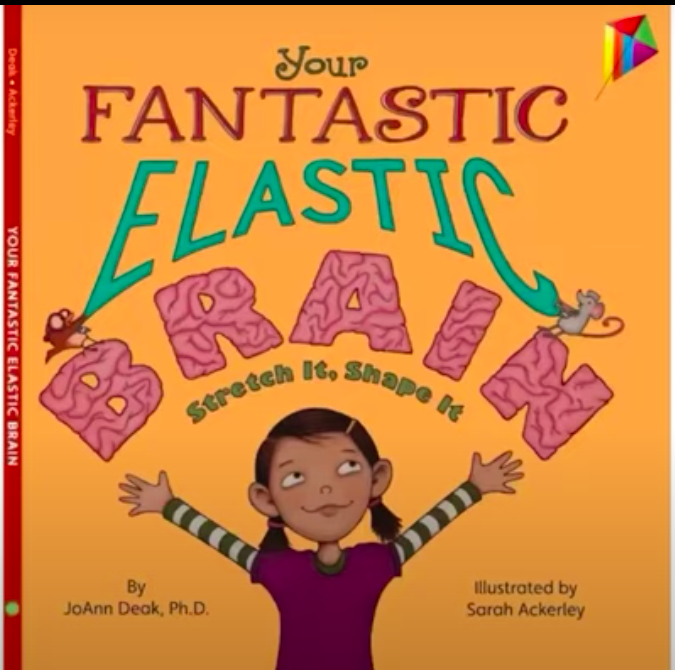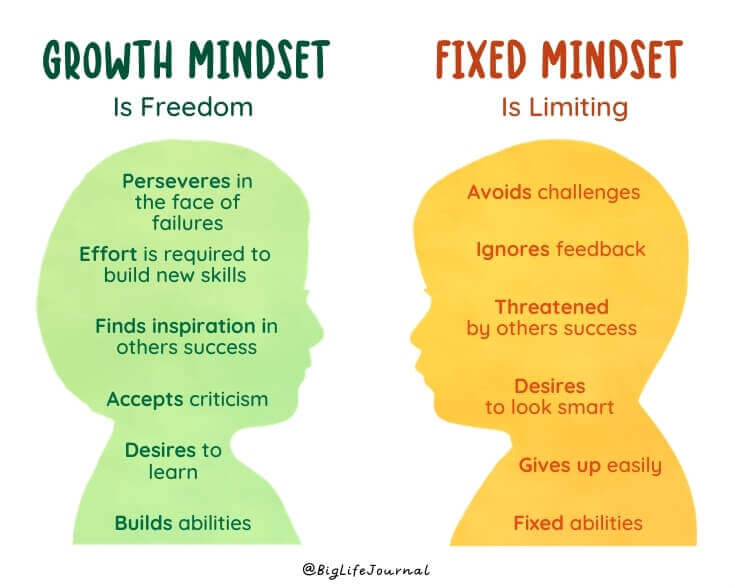Growth versus Fixed: Mindsets Matter

https://medium.com/stanford-magazine/carol-dweck-mindset-research-eb80831095b5
Think of yourself as a learner. How did you get to where you are right now? What belief system helped you get there? Or what belief system adversely impacted your journey in getting where you want to be?
In 2006, Carol Dweck, an American psychologist, author and professor at Stanford University, published a book called Mindset: The New Psychology of Success (Kazakoff & Mitchell, 2017) and after 1 million copies sold, the idea of a growth and fixed mindset became extremely well known, especially in the areas of psychology and education. Dweck coined the terms growth and fixed mindsets to refer to beliefs that people have regarding learning and intelligence (Robinson, 2022). People who have a fixed mindset believe that intelligence is unchangeable and the skills they have are innate. They are focused on performance goals (Fraser, 2017) to prove their abilities. They are averse to constructive feedback and threatened by others’ success (Rhew et al., 2018).
On the other hand, people who take on a growth mindset believe in “an incremental theory of intelligence whereby intelligence can grow and be developed through effort” (Dweck, 2010, as cited in Fraser, 2017,1-2). Someone who has a fixed mindset towards learning may give up easily in the face of challenges, while one who has a growth mindset sees challenges and setbacks as opportunities for learning and growing (Rhew et al., 2018). They regard intelligence as malleable and can be changed or developed (Rhew et al., 2018).
Mindsets play an important role in student motivation and engagement (Fraser, 2017). If students believe that they are born with a set of abilities that cannot be changed (fixed mindset), they might not be so motivated to grow or improve their abilities. This pattern of thinking can easily dampen one’s engagement to discover more or learn further. On the other hand, if students believe that the abilities they possess are a starting point (Louick, 2021), and with effort and hard work, they have the potential to increase their abilities (growth mindset), this type of thinking sets them on a different path. Students who believe they can develop what they have will be motivated to do more, to put in the effort because they know that hard work pays off.
As you talk to students about how the brain grows when one learns something new and when encounters challenges, read this book called “Your Fantastic, Elastic Brain” by JoAnn Deak, illustrated by Sarah Ackerly. It talks about the brain from a scientific perspective, and yet simple enough that even primary students can understand.

Teachers as Facilitators
ISTE Standard for Educator 2.6 calls upon educators as facilitators, that is, ‘educators facilitate learning with technology to support student achievement of the ISTE Standards for Students (ISTE, 2017). What is a facilitator? A facilitator, by definition, is someone who makes things easier or more accessible. When you think of a teacher as someone who facilitates learning for their students, a paradigm shift transpires. A teacher, in the traditional sense, might be seen as someone who is the source of all information and who tells students what they need to learn or do. A facilitator, on the other hand, gives students the opportunity to think for themselves, to discover, to ask questions, to dialogue with each other and to make discoveries that are meaningful and relevant to themselves. Teachers in a facilitative role guide students to become the drivers of their own learning (Harrington et al., 2019) by pursuing goals they have set for themselves.

https://biglifejournal.com/blogs/blog/growth-mindset-vs-fixed-mindset-differences-and-how-to-shift-your-childs-mindset
Leveraging Technology to Promote Growth Mindset
ISTE Standard for Educators 2.6.a speaks about fostering a culture where students take ownership of their learning goals and outcomes in both independent and group settings (ISTE, 2017). As facilitators in our classrooms, how do we foster this culture of taking risks and to make room for mistakes as instruments of growth? “Research has demonstrated that praising a student’s intelligence is not the best way to motivate learning” (Kazakoff & Mitchell, 2017, p. 2). Dweck (2010, as cited in Kazakoff & Mitchell, 2017) reminds us that our role in a growth mindset-focused classroom is to collaborate with students to grow their knowledge. In Carol Dweck’s TedTalk called “The Power of Believing That You Can Improve,” (2014), she talks about how we can praise wisely by praising the process – the effort, the strategies, the focus and all the work involved in the learning, instead of praising intelligence and abilities. Nurturing the hard work that students put in motivates them to keep working hard, even in the face of challenges. When we highlight the process, we help develop an intrinsic motivation for learning where students begin to take interest in how they are learning, and not solely focused on the end results (Rhew et al., 2018).
Growth mindset classrooms are learning spaces that fuel questioning, encourage risk-taking, promote collaborating with peers and make room for mistakes and failures. These supportive learning environments allow students to participate in decision-making and provide tasks that are engaging and meaningful, and differentiated to suit students’ needs and abilities (Kazakoff & Mitchell, 2017). These principles not only promote a growth mindset, but they also enhance student ownership and responsibility.
How can we use technology to promote a growth mindset?
- Daily check-in using digital forms: a way for teachers to establish a connection to each student in a personalized way. It provides immediate feedback to students. Daily check-ins provide a great conversation starter and contribute to establishing a positive classroom culture.
- Encourage risk-taking: use apps to encourage students to set goals, monitor their own progress, create learning plans to demonstrate what they know, and reflect on their learning (Promethean, 2018).
- Continuous feedback on ongoing effort: use digital tools that allow teachers to provide real-time feedback and let students see how much time they spend on a particular activity to help them track how much they have yet to complete (Kazakoff and Mitchell, 2017).
- Work around setbacks: challenges, mistakes, failures are all inherent in learning (Promethean, 2018).
“The perspective of a fixed mindset is that failure is evidence of lack of intelligence, while the growth mindset embraces the challenges and setbacks along the way and continues to find a solution” (Promethean, 2018).
- Meaningful learning tasks: these tasks can be differentiated and adjusted to account for learner differences. Meaningful tasks that match specific learning objectives give teachers relevant information regarding student understanding of specific goals (Kazakoff and Mitchell, 2017).
- Encourage collaboration: learning is a social process and is enriched by the contribution of others in the learning community. During collaborative tasks, students learn to listen to and give feedback. They can choose to share their feedback using various digital tools and they can share their learning with peers in different ways.
Resources for teaching growth mindset
- How to Teach Growth Mindset to Kids (The 4-Week Guide). From Big Life Journal. https://biglifejournal.com/blogs/blog/teach-growth-mindset-kids-activities
This resource gives a very practical and doable framework for teaching the growth mindset in a reasonable amount of time. The 4-week guide is divided into 4 lessons. Each week’s lesson is divided into steps and comes with resources ready for use, such as printable worksheets, videos, titles of books for reading aloud, and even a script you might want to use if you are not sure what to say. It seems very user friendly and efficient as all the accompanying materials to the lesson are already linked.
Here is the big idea for each of the 4 weeks:
Week 1: Introduce it
Week 2: Notice it
Week 3: Model it
Week 4: Practice it
2. ClassDojo (https://www.classdojo.com/), an online resource to connect classrooms and families, produced a 5-video series on the growth mindset. The series is about a friendly monster named Mojo and his friend Katie and together, they discover some important things about their brains and how challenges can make their brains stronger. Each episode is about 3 minutes long, and discussion questions follow each episode.
Episode 1: Your Brain is like a Muscle
Episode 2: The Magic of Mistakes
Episode 3: The Incredible Power of Yet
Episode 4: The Mysterious World of Neurons
Episode 5: Mojo Puts It All Together Working
3. EdPuzzle (https://edpuzzle.com): EdPuzzle is a digital tool that helps you create interactive videos and customize them to fit learning objectives and goals. You can use EdPuzzle to show growth mindset videos and choose to embed questions at certain points in a video presentation to get them thinking about their own growth mindset. To get started, teachers can use their own videos or choose one from the EdPuzzle library. It has both a free version and a paid version, like with most apps. Common Sense Education gives EdPuzzle 4 stars out of 5 for student engagement and pedagogy. EdPuzzle can be integrated into many learning management systems, such as Google Classroom, and Schoology.
Resources
biglifejournal.com. (2017). How to Teach Growth Mindset to Kids (The 4-Week Guide). Big Life Journal. https://biglifejournal.com/blogs/blog/teach-growth-mindset-kids-activities
ClassDojo. (2019). Learn all about ClassDojo. ClassDojo. https://www.classdojo.com/
Dweck, C. (2014). How Can You Develop a Growth Mindset About Teaching? Educational Horizons, 93(2), 15–15. http://www.jstor.org/stable/24637292
Dweck, C. (2014, November). The power of believing that you can improve. Ted.com; TED Talks. https://www.ted.com/talks/carol_dweck_the_power_of_believing_that_you_can_improve?language=en
Dweck, C. (2016, January 13). What having a “growth mindset” actually means. Harvard Business Review.
Fraser, D. M. (2017). An exploration of the application and implementation of growth mindset principles within a primary school. British Journal of Educational Psychology, 88(4), 1-14. https://doi.org/10.1111/bjep.12208
Harrington, A., Henry, R., Milligan, R., Morel, N., & Osteen, J. (2019). Students Take Ownership of Learning. https://learningforward.org/wp-content/uploads/2019/08/students-take-ownership-of-learning.pdf
International Society for Technology in Education (ISTE). (2017). ISTE Standards for Educators | ISTE. Www.iste.org. https://www.iste.org/standards/iste-standards-for-teachers
Jennings, C., & Cuevas, J. A. (2021). Teacher Impact on Student Growth Mindset. Perspectives In Learning, 19 (1). Retrieved from https://csuepress.columbusstate.edu/pil/vol19/iss1/4
Kazakoff, E., & Mitchell, A. (2017). Cultivating a Growth Mindset with Educational Technology. Lexialearning.com.
Louick, R. (2021, June 25). Growth Mindset vs. Fixed Mindset: Key Differences and How to Shift Your Child’s Mindset. Big Life Journal. https://biglifejournal.com/blogs/blog/growth-mindset-vs-fixed-mindset-differences-and-how-to-shift-your-childs-mindset
Promethean. (2018, May 31). Are you using tech to develop a growth mindset? Promethean Blog. https://resourced.prometheanworld.com/develop-growth-mindset-with-tech/
Rhew, E., Piro, J. S., Goolkasian, P., & Cosentino, P. (2018). The effects of a growth mindset on self-efficacy and motivation. Cogent Education, 5(1). https://doi.org/10.1080/2331186x.2018.1492337
Robinson, C. (2017). Growth mindset in the classroom. Science Scope, 41(2), 18–21. http://www.jstor.org/stable/26387192

Thank you for this wonderful post Chelly. I am a huge believer in growth mindset and regularly talk to my students, as well as my own child, about it. I really like your suggestion of using digital check-in forms as a way to establish connections with students. Some students may be more likely to write down an issue they are having rather than say it to someone’s face as that can feel overwhelming.
Thanks for sharing a great post, Chelly. I am a big fan of a growth mindset. As an educator, this mindset plays an essential role in assisting students to fuel questioning, encourage risk-taking, promote collaboration with peers, and make room for mistakes and failures. I agree with this statement.